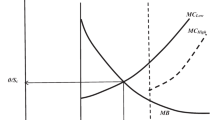Abstract
This paper extends existing equilibrium commercial mortgage pricing models by endogenizing negotiated workout into the usual noncooperative lending game. Workout is a feasible subgame strategy for the lender to play whenever foreclosure transaction costs exist for either party to a loan transaction. In particular, negotiated workout solutions Pareto dominate the foreclosure alternative when default occurs. To obtain our results, we embed a cooperative bargaining game within a noncooperative mortgage loan/default game. We also address the valuation “wedge” problem that occurs when foreclosure transaction costs are introduced. Through the notion of replacement game equilibrium, we find symmetric mortgage pricing solutions that eliminate the valuation wedge and thus suggest that lending will occur in commercial real estate mortgage markets even when foreclosure transaction costs exist.
Similar content being viewed by others
References
Augustine, Patrick B. “An Ounce of Prevention: Reducing the Risk of Emotional Verdicts,”Banking Law Review 3 (1991), 8–18.
Bates, Bruce A. “Setting the Rules for Workout Negotiations in Advance,”Journal of Commercial Bank Lending 73 (1991), 54–60.
Berg, J., L. Daley, J. Dichaut, and J. O'Brien. “Controlling Preferences for Lotteries on Units of Experimental Exchange,”Quarterly Journal of Economics 201 (1986), 281–306.
Binmore, Ken G. “Nash Bargaining Theory II.” InThe Economics of Bargaining. Oxford: Blackwell, 1987.
Binmore, Ken.Fun and Games. Lexington, MA: D.C. Heath and Company, 1992.
Ciochetti, Brian. “Credit Risk Diversification in Commercial Mortgage Portfolios.” Unpublished Dissertation, (1993), University of Wisconsin-Madison.
Cunningham, Donald F., and Patric Hendershott. “Pricing FHA Mortgage Default Insurance,”Housing Finance Review 3 (1984), 373–392.
Curry, Timothy, Joseph Blalock, and Rebel Cole. “Recoveries on Distressed Real Estate and the Relative Efficiency of Public vs. Private Mangement,”AREUEA Journal 19 (1991), 495–515.
Dunn, Kenneth B., and Chester S. Spatt. “An Analysis of Mortgage Contracting: Prepayment Penalties and Due-on-Sale Clause,”Journal of Finance 40 (1985), 293–308.
Green, Jerry, and Jean-Jacques Laffont. “Renegotiation and the Form of Efficient Contracts,” Unpublished Manuscript, (1988), Harvard University.
Hart, Oliver, and John Moore. “Incomplete Contracts and Renegotiation,”Econometrica 56 (1988), 755–786.
Haugen, Robert A., And Lemma W. Senbet. “The Insignificance of Bankruptcy Costs to the Theory of Optimal Capital Structure,”Journal of Finance 33 (1978), 383–393.
Hendershott, Patric H., and Robert Van Order. “Pricing Mortgages: An Interpretation of Models and Results,”Journal of Financial Services Research 1 (1987), 19–55.
Huberman, Gur, and Charles Kahn. “Limited Contract Enforcement and Strategic Renegotiation,”American Economic Review 78 (1988), 471–484.
Kau, James B., Donald C. Keenan, Walter S. Muller III, and James F. Epperson. “Pricing Commercial Mortgages and Their Mortgage-Backed Securities,”Journal of Real Estate Finance and Economics 3 (1990), 333–356.
Kau, James. B., Donald C. Keenan, and Taewon Kim. “Transaction Costs, Suboptimal Termination, and Default Probabilities,”AREUEA Journal 21, (1993), 247–263.
Modigliani, Franco, and Merton H. Miller. “The Cost of Capital, Corporation Finance, and the Theory of Investment,”American Economic Review 48 (1958), 261–297.
Osborne, Martin J., and Ariel Rubinstein.Bargaining and Markets. New York, NY: Academic Press Inc., 1990.
Rubinstein, Ariel, “Perfect Equilibrium in a Bargaining Model,”Econometrica 50 (1982), 97–109.
Rubinstein, Ariel, and Asher Wolinsky. “Renegotiation-Proof Implementation and Time Preferences,”American Economic Review 82 (1992), 600–614.
Snyderman, Mark. “Commercial Mortgages: Default Occurrence and Estimated Yield Impact,”Journal of Portfolio Management, (Fall 1991), 82–87.
Titman, Sheridan, and Walter Torous. “Valuing Commercial Mortgages: An Empirical Investigation of the Contingent-Claims Approach to Pricing Risky Debt,”Journal of Finance 44 (1989), 345–373.
Vandell, Kerry D. “On Transaction Costs and the Default Option.” Unpublished Manuscript, (1987), Southern Methodist University.
Author information
Authors and Affiliations
Rights and permissions
About this article
Cite this article
Riddiough, T.J., Wyatt, S.B. Strategic default, workout, and commercial mortgage valuation. J Real Estate Finan Econ 9, 5–22 (1994). https://doi.org/10.1007/BF01153586
Issue Date:
DOI: https://doi.org/10.1007/BF01153586



